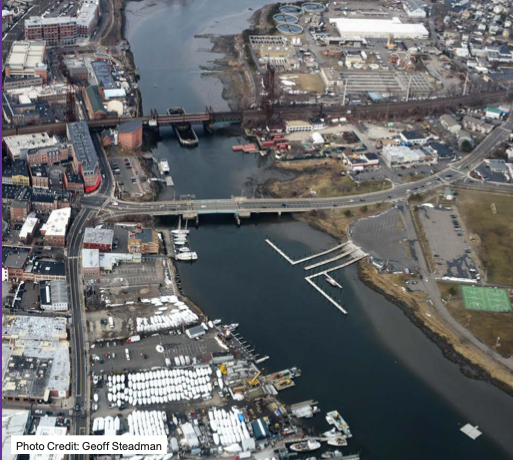October 22, 2021
 Norwalk recently underwent a study of its industrial zones to take a look at the different types of industrial development in various areas of the city, and how industrial and commercial zoning can best be used for economic and job growth.
Norwalk recently underwent a study of its industrial zones to take a look at the different types of industrial development in various areas of the city, and how industrial and commercial zoning can best be used for economic and job growth.
How can the city become more modernized? How should the city change the industrial zone definition? What should industrial zones look like in Norden Place and along the waterfront?
These are just a few questions examined in the study.
The Norwalk Industrial Zone Study included conversations with city staff, industrial business owners, residents, and other local stakeholders. Below is a quick overview of the study’s recommendations.
Simplify Zoning Classifications for Modern Uses
Industry in Norwalk has evolved over the years. Commercial zones previously developed for agriculture and manufacturing need modernization. Yet, the city still needs to make room to attract construction projects and other heavy industrial works.
One recommendation of the Industrial Zone Study is to simplify zone classifications to make them more in line with contemporary uses. This would distinguish each zone class by the type of industrial uses allowed, the types of contractors permitted, and whether or not residential uses in the zones are permitted.
There are four proposed industrial categories for the zoning districts:
- Heavy Industrial – this include intensive manufacturing, contractor yards, utilities and waste management
- Mixed-use Heavy Industrial/Commercial – this includes heavy industry but also allows commercial upper floor uses such as offices, research and development, showrooms, and other industrial services.
- Mixed-use Light Industrial/Commercial – this would include light manufacturing uses, as well as research and development, limited warehousing, and other less intensive industrial services.
- Mixed-use Artisan – these zones would allow boutique manufacturing, textile companies, bakeries, beverage and spirits production, and artist studios.
Special Development Plan for Norden Place
Norden Place is a unique area because of its industrial history and location. The site takes up more than three dozen acres in Norwalk and is an ideal location for an industrial zone. However, there are specific challenges that need to be addressed when planning for its future use. For one, it is adjacent to I-95, yet drivers must go through residential areas to access the highway.
The study recommends preparing a development plan just for the Norden site. While a warehousing center for Norden Place may not be ideal, mixed commercial/industrial users should be able to make use of the location. Potential uses might include research and development, life science and biotech companies, or a data center. Importantly, they should discourage residential uses.
Along with the planning for Norden Place, the city should examine and devise a plan for access to I-95. It may be possible to open additional ramps to the highway, though it’s important to bear in mind the effects of these construction projects on city residents. One solution could be including buffering strategies to minimize noise pollution along the highway. They may also want to restrict vehicular traffic in the zone to passenger vehicles and small trucks only.
Differentiate Between Contractor Yards and Others
While contractor yards are permitted in industrial zones, contractors can include a large array of service providers from plumbers and electricians to site contractors and sand/gravel storage facilities. The sweeping term ignores the realities that each industry has its own needs and in zones with more intensive contractor yards and heavy industry conflicts can arise when they are intermingled with residential uses.
The study proposes that the city should distinguish between contractor yards with heavy truck traffic and impact on the site, and contractor offices that have only a few service vehicles and less effect on its surroundings. Distinctions should also be drawn between contractor operations with outdoor vs. indoor storage.
Some other requirements suggested for zoning regulations for contractor yards include:
- Locating them in accessible locations that will not cause traffic problem
- Adding buffers adjacent to these yards and access to major roadways
An additional recommendation of the Norwalk Zoning Study is limiting self-storage facilities, which are presently under a moratorium in the industrial zones. The reason for this is that self-storage takes up valuable industrial land, but is not the best use of the property. These facilities provide limited jobs and economic development potential, and don’t promote an active pedestrian environment on the ground floor such as retail or restaurants, which add to the vitality of the neighborhood.
Develop a Unique Waterfront Plan
Historically, Norwalk has had industrial zones along the Norwalk River, but this waterfront is a unique area with many uses, regulations, and other pressures. The plan suggests that the city should take into consideration the many other issues that affect the land use along the waterfront, including the environmental impact, water quality, coastal resiliency, public access, recreational uses, as well as economic development opportunities related to the water.
In fact, the city has already begun to develop an Industrial Waterfront Land Use Plan to determine the best use of its waterfront, taking into account the many diverse challenges.
How Norwalk Industrial Zones Can Improve
Norwalk industrial zones can become more effective for today’s economy. By differentiating between different kinds of industry and creating new classifications the city can accommodate a larger variety of businesses and more mixed-use buildings.
Norden Place and the waterfront are two industrially zoned areas that are unique and should be studied, planned, and developed separately.
By taking steps outlined in the Industrial Zone Study, Norwalk is planning for the future. A future that encourages economic development balanced with residents’ needs and the environment.




